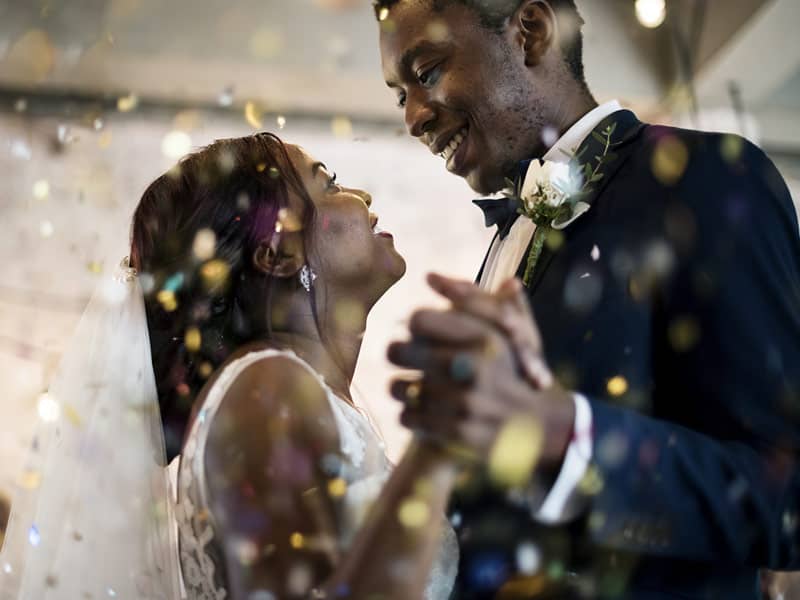A walk of love. The description came from the father of the groom in the first wedding I held on a labyrinth. I think the words describe the possibilities that labyrinths can bring to all sorts of ceremonies. The duality of the labyrinth--connecting the physical act of walking with the inner, spiritual passages--resonates with the duality of public ceremonies.
 A wedding is often called a "public affirmation of a private commitment." Walking the labyrinth in a ceremony can connect you both to the community of friends--who can witness and acknowledge the event from the perimeter of the circle--and to the larger community of humankind across cultures and generations. For thousands of years, labyrinths have been interwoven into rituals in cultures from Europe to Asia to South and North America.
A wedding is often called a "public affirmation of a private commitment." Walking the labyrinth in a ceremony can connect you both to the community of friends--who can witness and acknowledge the event from the perimeter of the circle--and to the larger community of humankind across cultures and generations. For thousands of years, labyrinths have been interwoven into rituals in cultures from Europe to Asia to South and North America. The idea of using labyrinths in weddings arose soon after I started my labyrinth work. After the second public walk I facilitated, a young man who happened to be the son of a dear friend spoke to me about his girlfriend walking the labyrinth on New Year's Eve 1993. "I realized in that moment, when I saw her at the center, that this was the woman I wanted to marry, and that I wanted to marry her on the labyrinth," he said. At the time, he confided to me, he had not yet asked her to marry him.
Eventually he asked her and she accepted. I worked with the couple for a year and a half; together we created their personal ceremony on the labyrinth. The preparations included painting a special ceremonial three-circuit labyrinth wide enough for them to walk together. At the same time, I was called to be ordained into the interfaith ministry of the Universal Brotherhood Movement, so that I could perform the wedding.
I have gone on to officiate several other weddings on the labyrinth. The couples all have their unique stories. One couple who chose a labyrinth wedding, for example, had had a relationship more than twenty years before. Each had gone on to marry someone else. Through a set of odds-defying circumstances, they met up again and realized they were right for each other. The labyrinth walk that was part of their ceremony seemed to be a metaphor for the twists of fate that brought them together, sent them apart, then brought them together again to marry. As they separately walked the path in, they came close and then walked next to each other. Then their paths would diverge, just as it had happened in their lives.
Weddings on the labyrinth are wonderful and have a completely different feel than traditional weddings. Rather than the traditional walk down the "straight and narrow" of the church aisle, the couple walk around the paths and turns of the labyrinth--a much more accurate metaphor for the journey they are embarking upon. Where many modern weddings seem to be rushed, the labyrinth wedding slows down time. It also seems to connect the participants and observers to the sacred in a way that many modern weddings don't. It's hard for the bride and groom not to connect to their inner journey as they walk the labyrinth--and it's hard for the observers not to be drawn to the center with them. Traditional weddings are familiar and predictable. Labyrinth weddings are anything but.
My labyrinth wedding ceremony usually starts with the guests seated in chairs forming concentric circles around the labyrinth. Once everyone is seated, I walk into the center to create sacred space. Even if the wedding is in a church, I still feel the need to set sacred space and so I have a reading that I have developed over the years that works very nicely to explain the labyrinth and relate it to the marriage ceremony. It also leads into the image of the circle as it relates to marriage and the rings. The blessing and the labyrinth together emblemize these connections beautifully.
Sometimes we orchestrate it so that the groom gets to the center before the bride arrives. Sometimes we arrange the groom's walk so that he does not get all the way to the center before the bride arrives. He will only have begun his journey and stopped part way around as she comes to the entrance. He will often just stand still while she is blessed by her family and friends, again as simply or as elaborately as they choose. Now both the bride and groom are walking the labyrinth.
As in life, the two of them have begun their journeys separately; the labyrinth allows this reality to be reflected. At this time they are both moving around in circles, both on the same path, heading to the same place, yet not walking together. They pass each other, which is really powerful because you know they are eventually going to meet. The groom gets to the center. He waits for her. The bride arrives and they come together at the center. Often at this point, there are selected readings by friends or family members. If it's a second marriage for either one of them, and there are children, the children come in. The couple then exchange their vows.
So far, all the couples have chosen to be in the center by themselves, although there is no particular rule about that, and I could certainly be there with them if they wished. Still, I like the image of them standing alone in the center: They marry each other, I don't marry them.
When the couple walks out together after exchanging vows and rings, it's a lovely image. There is generally music. Some people choose to have additional readings. I meet them at the entrance again for the final blessing.
I love to use the Apache Wedding Blessing because it is gorgeous, resonating with meaning and poetry in a very tender and appropriate way.
There are many variations on this basic outline. At a wedding I officiated in Virginia, the couple wanted the center piece of their ceremony to be straight out of the Book of Common Prayer. They created a wonderful opening and closing to make it more personal. Other times, the couples have written the whole ceremony. I think that's appropriate because it's their day. I ask them to reflect on this question: What do you want to say to each other? I have also co-facilitated a wedding with an Episcopal priest. I went in initially, set the sacred space, and stood next to him while he did the traditional Episcopal service. Then I read the Apache Wedding Blessing as the closing prayer.
The Apache Wedding Blessing:
Now you will feel no rain, for each of you will be shelter to the other. Now you will feel no cold, for each of you will be warmth to each other. Now there is no more loneliness for you, for each of you will be comfort to the other. Though you are two bodies, there is but one life before you. Go now to your dwelling place to enter into the days of your togetherness and may the days of your life be good and long upon the earth. Amen.

